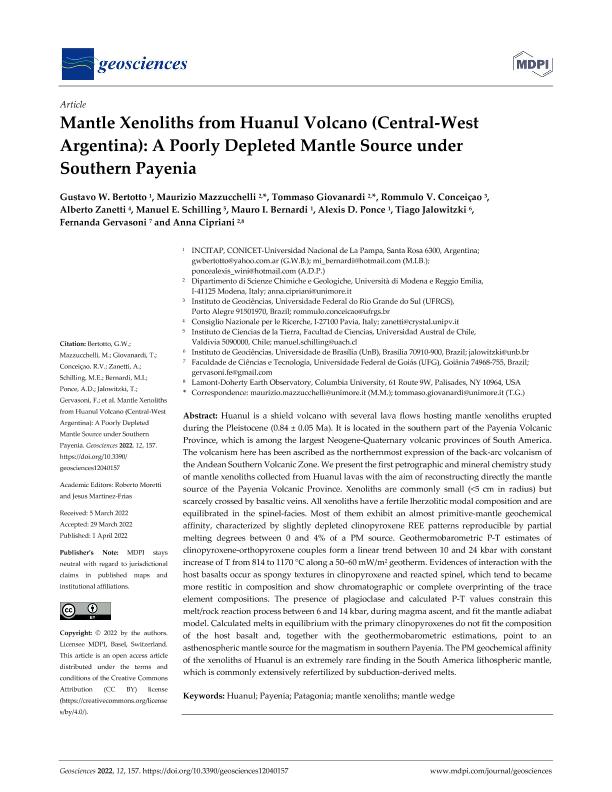Artículo
Mantle Xenoliths from Huanul Volcano (Central-West Argentina): A Poorly Depleted Mantle Source under Southern Payenia
Bertotto, Gustavo Walter ; Mazzucchelli, Maurizio; Giovanardi, Tommaso; Conceiçao, Rommulo V.; Zanetti, Alberto; Schilling, Manuel E.; Bernardi, Mauro Ignacio
; Mazzucchelli, Maurizio; Giovanardi, Tommaso; Conceiçao, Rommulo V.; Zanetti, Alberto; Schilling, Manuel E.; Bernardi, Mauro Ignacio ; Ponce, Alexis Daniel
; Ponce, Alexis Daniel ; Jalowitzki, Tiago; Gervasoni, Fernanda; Cipriani, Anna
; Jalowitzki, Tiago; Gervasoni, Fernanda; Cipriani, Anna
 ; Mazzucchelli, Maurizio; Giovanardi, Tommaso; Conceiçao, Rommulo V.; Zanetti, Alberto; Schilling, Manuel E.; Bernardi, Mauro Ignacio
; Mazzucchelli, Maurizio; Giovanardi, Tommaso; Conceiçao, Rommulo V.; Zanetti, Alberto; Schilling, Manuel E.; Bernardi, Mauro Ignacio ; Ponce, Alexis Daniel
; Ponce, Alexis Daniel ; Jalowitzki, Tiago; Gervasoni, Fernanda; Cipriani, Anna
; Jalowitzki, Tiago; Gervasoni, Fernanda; Cipriani, Anna
Fecha de publicación:
04/2022
Editorial:
MDPI
Revista:
Geosciences
ISSN:
2076-3263
Idioma:
Inglés
Tipo de recurso:
Artículo publicado
Clasificación temática:
Resumen
Huanul is a shield volcano with several lava flows hosting mantle xenoliths erupted during the Pleistocene (0.84 ± 0.05 Ma). It is located in the southern part of the Payenia Volcanic Province, which is among the largest Neogene-Quaternary volcanic provinces of South America. The volcanism here has been ascribed as the northernmost expression of the back-arc volcanism of the Andean Southern Volcanic Zone. We present the first petrographic and mineral chemistry study of mantle xenoliths collected from Huanul lavas with the aim of reconstructing directly the mantle source of the Payenia Volcanic Province. Xenoliths are commonly small (<5 cm in radius) but scarcely crossed by basaltic veins. All xenoliths have a fertile lherzolitic modal composition and are equilibrated in the spinel-facies. Most of them exhibit an almost primitive-mantle geochemical affinity, characterized by slightly depleted clinopyroxene REE patterns reproducible by partial melting degrees between 0 and 4% of a PM source. Geothermobarometric P-T estimates of clinopyroxene-orthopyroxene couples form a linear trend between 10 and 24 kbar with constant increase of T from 814 to 1170 °C along a 50–60 mW/m2 geotherm. Evidences of interaction with the host basalts occur as spongy textures in clinopyroxene and reacted spinel, which tend to became more restitic in composition and show chromatographic or complete overprinting of the trace element compositions. The presence of plagioclase and calculated P-T values constrain this melt/rock reaction process between 6 and 14 kbar, during magma ascent, and fit the mantle adiabat model. Calculated melts in equilibrium with the primary clinopyroxenes do not fit the composition of the host basalt and, together with the geothermobarometric estimations, point to an asthenospheric mantle source for the magmatism in southern Payenia. The PM geochemical affinity of the xenoliths of Huanul is an extremely rare finding in the South America lithospheric mantle, which is commonly extensively refertilized by subduction-derived melts.
Palabras clave:
HUANUL
,
MANTLE WEDGE
,
MANTLE XENOLITHS
,
PATAGONIA
,
PAYENIA
Archivos asociados
Licencia
Identificadores
Colecciones
Articulos(INCITAP)
Articulos de INST.D/CS D/L/TIERRA Y AMBIENTALES D/L/PAMPA
Articulos de INST.D/CS D/L/TIERRA Y AMBIENTALES D/L/PAMPA
Citación
Bertotto, Gustavo Walter; Mazzucchelli, Maurizio; Giovanardi, Tommaso; Conceiçao, Rommulo V.; Zanetti, Alberto; et al.; Mantle Xenoliths from Huanul Volcano (Central-West Argentina): A Poorly Depleted Mantle Source under Southern Payenia; MDPI; Geosciences; 12; 4; 4-2022; 1-23
Compartir
Altmétricas



